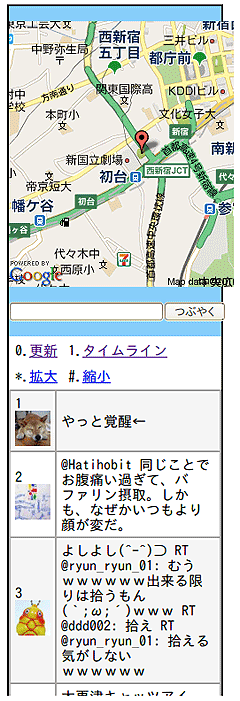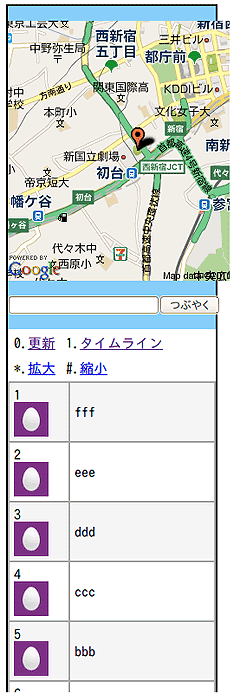携帯の醍醐味! 位置情報とGoogleマップを使うには:クラウドとフレームワークで超簡単ケータイ開発(3)(3/3 ページ)
Google Static Maps APIで地図画像を表示
それでは、「Google Static Maps API version2」を使用して、Googleマップを表示してみましょう。
まず「com.hayato.gpstweet.service.TwitterService」を以下のように編集します。
TwitterService クラスに地図のデフォルトズームレベルを表す定数「DEFAULT_MAPZOOM」を作成します。次に、GoogleマップのURIを作成するgetMapURI()を作成します。引数に緯度、経度、ツイートの位置情報(markers形式)、ズームレベルを指定します。
次に「com.hayato.gpstweet.controller.twitter.ShowController」を以下のように編集します。GoogleマップのURIを作成するcreateMap()メソッドを追加します。
……【略】……
// GoogleMapsの画像URI作成
private void createMap(Double latitude, Double longitude)
throws TwitterException {
// ツイートの位置情報をmarkers形式で取得する
String tweetLocation = getTweetLocation();
// ズームレベルをリクエストから取得する
Integer mapzoom = asInteger("mapzoom");
// GoogleMapの画像URI作成
String mapURI =
service.getMapURI(latitude, longitude, tweetLocation, mapzoom);
requestScope("mapURI", mapURI);
}
……【略】……検索結果のツイートから位置情報を取得して、markers形式に変換するためにgetTweetLocation()メソッドを追加します。ズームレベルは、リクエストに持たせ、そこから取得します。
……【略】……
// ツイートの位置情報をmarkers形式で取得する
private String getTweetLocation() {
List tweetList = requestScope("tweets");
// ツイートの位置情報をmarkers形式にする
String tweetLocation = "";
for (int i = 0; i < tweetList.size(); i++) {
Tweet tweet = tweetList.get(i);
if (tweet.getGeoLocation() != null) {
tweetLocation +=
"&markers=label:" + i + "|size:mid|color:red|"
+ tweet.getGeoLocation().getLatitude() + ","
+ tweet.getGeoLocation().getLongitude() + "&";
}
}
return tweetLocation;
}
……【略】…… tweet.getGeoLocation()メソッドでツイートの位置情報が取得できます。labelに数字を指定したmarkers形式に変換します。
run()にズームレベルをリクエストに保存するロジックを追加し、処理の最後に、createMap()を呼び出し、Googleマップを作成するようにします。
……【略】……
// 位置情報による検索
@Override
public Navigation run() throws Exception {
Double latitude, longitude;
// ズームレベル(デフォルト値を設定)
Integer mapzoom = TwitterService.DEFAULT_MAPZOOM;
// 位置情報を取得していない場合
if (requestScope("latitude") == null) {
Gps gps = getGps();
latitude = gps.getLat();
longitude = gps.getLon();
// 位置情報をリクエストに保存する
requestScope("latitude", latitude);
requestScope("longitude", longitude);
// ズームレベルをリクエストに保存する
requestScope("mapzoom", mapzoom);
} else {
// リクエストから位置情報を取得する
latitude = asDouble("latitude");
longitude = asDouble("longitude");
}
// 位置情報を指定して、TwitterServiceを呼び出す
List<Tweet> tweetList =
service.search(latitude, longitude).getTweets();
requestScope("tweets", tweetList);
// GoogleMapsの画像URI作成
createMap(latitude, longitude);
return forward("show.jsp");
}……【略】……JSPファイル「war/twitter/show.jsp」を以下のように編集します。
……【略】……
<body style="border: 2px solid black;">
<div style="background: none repeat scroll 0% 0% #87CEFA;">
<br>
<table border="0" cellpadding="0" cellspacing="0">
<tbody>
<tr>
<td valign="top">
<img src="${mapURI}">
</td>
</tr>
</tbody>
</table>
<br>
<form method="post" action="tweet" style="margin: 0pt; padding: 0pt;">
……【略】……<form>タグの前にGoogleマップを表示するために<img>タグを配置します。srcに先ほどの「${mapURI}」を指定します。
……【略】……
<form method="post" action="tweet" style="margin: 0pt; padding: 0pt;">
<input name="latitude" value="${latitude}" type="hidden">
<input name="longitude" value="${longitude}" type="hidden">
<input name="mapzoom" value="${mapzoom}" type="hidden">
……【略】……<form>タグのhidden項目に「${mapzoom}」を保持します。
……【略】……
<td style="padding: 5px;">
<c:url value="/twitter/show" var="url" >
<c:param name="latitude" value="${latitude}"/>
<c:param name="longitude" value="${longitude}"/>
<c:param name="mapzoom" value="${mapzoom}"/>
</c:url>
0.<a href="${url}" accesskey="0">更新</a>
</td>
……【略】……更新やタイムラインのリンクにも、URLパラメータとして、「${mapzoom}」を設定します。
……【略】……
1.<a href="${url}" accesskey="1">タイムライン</a>
</td>
</tr>
<tr>
<td style="padding: 5px;">
<c:url value="/twitter/show" var="url" >
<c:param name="latitude" value="${latitude}"/>
<c:param name="longitude" value="${longitude}"/>
<c:param name="mapzoom" value="${mapzoom+1}"/>
</c:url>
*.<a href="${url}" accesskey="*">拡大</a>
</td>
<td style="padding: 5px;">
<c:url value="/twitter/show" var="url" >
<c:param name="latitude" value="${latitude}"/>
<c:param name="longitude" value="${longitude}"/>
<c:param name="mapzoom" value="${mapzoom-1}"/>
</c:url>
#.<a href="${url}" accesskey="#">縮小</a>
</td>
</tr>
……【略】……タイムラインのリンクの後に、地図の拡大、縮小のリンクを作成します。「com.hayato.gpstweet.controller.twitter.TimelineController」を以下のように編集します。
……【略】……
@Override
public Navigation run() throws Exception {
// タイムラインの取得
List<Status> statusList = service.getTimeline();
requestScope("tweets", statusList);
// リクエストから位置情報を取得する
Double latitude = asDouble("latitude");
Double longitude = asDouble("longitude");
// GoogleMapsの画像URI作成
createMap(latitude, longitude);
return forward("show.jsp");
}
……【略】……}TimelineControllerクラスでも同様にGoogleマップを作成します。
……【略】……
// ツイートの位置情報をmarkers形式で取得する
private String getTweetLocation() {
List<Status> statusList = requestScope("tweets");
// ツイートの位置情報をmarkers形式にする
String tweetLocation = "";
for (int i = 0; i < statusList.size(); i++) {
Status status = statusList.get(i);
if (status.getGeoLocation() != null) {
tweetLocation +=
"&markers=label:" + i + "|size:mid|color:red|"
+ status.getGeoLocation().getLatitude() + ","
+ status.getGeoLocation().getLongitude() + "&";
}
}
return tweetLocation;
}
……【略】……}タイムラインは、Statusクラスから位置情報を取得します。
……【略】……
@Override
public Navigation run() throws Exception {
……【略】……
// 位置情報をURLパラメータに設定して、ShowControllerにリダイレクトさせる
Object[] data = new String[]{
requestScope("latitude"),
requestScope("longitude"),
requestScope("mapzoom"),
};
String url = MessageFormat.format(
"show?latitude={0}&longitude={1}&mapzoom={2}", data);
return redirect(url);
……【略】……ShowControllerにリダイレクトさせる際に、mapzoomも設定するよう修正します。
モバイルの新時代を創りあげよう!
以上で完成です。以下、完成時の画面イメージです。
今回作成したサンプルのソースコードを「gpstweet - Project Hosting on Google Code」で公開しています。またアプリ自体は、Google App Engine上にデプロイしてあるので、触ってみてください。このアプリからつぶやいたツイートは、@gpstweetに反映されます。
本連載では3回にわたり、ケータイでTwitterの位置情報と地図を使ったサービスを一通り作ってみましたが、いかがでしたでしょうか。
Mobyletにより、簡単にケータイサイトが作れ、Twitter4jで簡単にTwitterと連携でき、Slim3を使用して、簡単にGoogle App Engineのクラウド上でアプリケーションが構築できることが実感していただければ幸いです。
ぜひ、皆さんもケータイサイトの構築にチャレンジしてみてください。これからは、ケータイやスマートフォンの時代です。皆さんで新しい時代を創りあげましょう!
関連記事
- クラウドで動くGPS連動スマホ用Webアプリを作る
たぶん1時間でできるマッシュアップ講座 - 位置情報を取得する仕組み
連載:位置情報を使ってみよう(1) - iPhoneで動かす業務用Webアプリ開発入門
- 携帯アプリを作って学ぶJava文法の基礎
Copyright © ITmedia, Inc. All Rights Reserved.

 図5 地図表示
図5 地図表示 図6 タイムライン表示
図6 タイムライン表示



